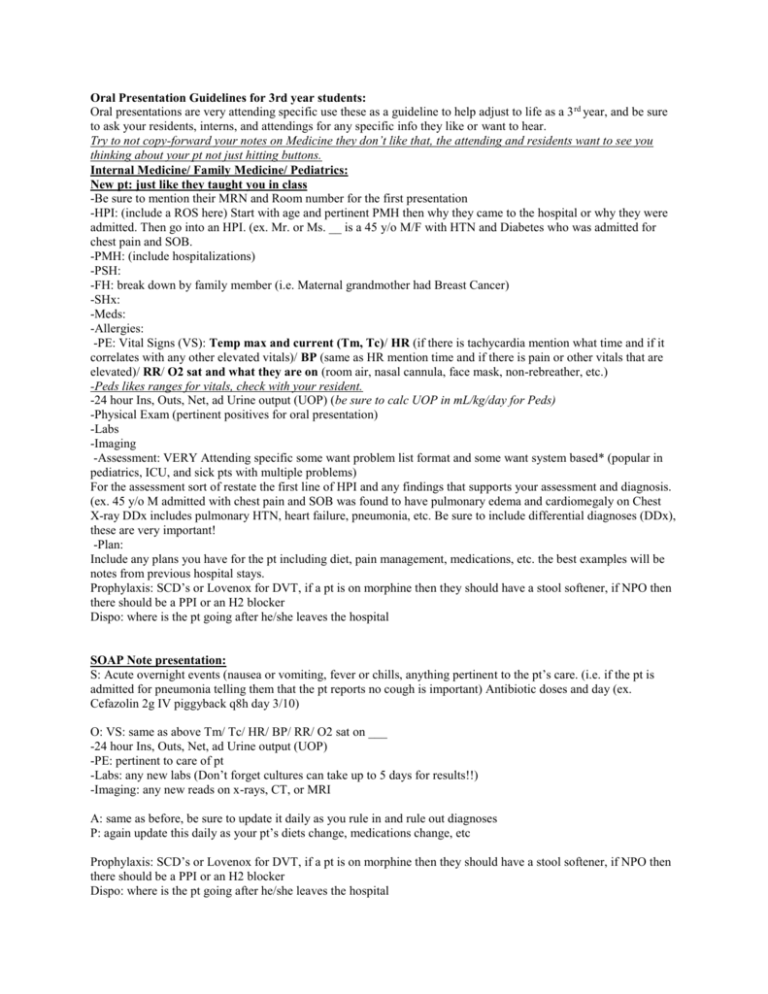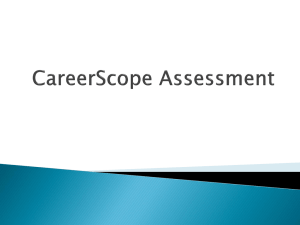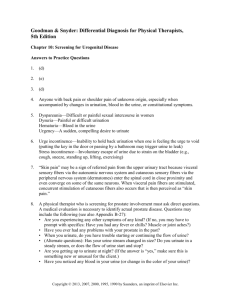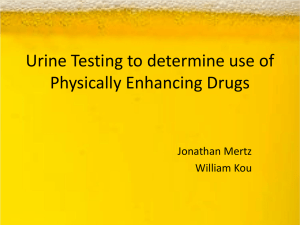Oral Presentation Guidelines for 3rd year students
advertisement

Oral Presentation Guidelines for 3rd year students: Oral presentations are very attending specific use these as a guideline to help adjust to life as a 3 rd year, and be sure to ask your residents, interns, and attendings for any specific info they like or want to hear. Try to not copy-forward your notes on Medicine they don’t like that, the attending and residents want to see you thinking about your pt not just hitting buttons. Internal Medicine/ Family Medicine/ Pediatrics: New pt: just like they taught you in class -Be sure to mention their MRN and Room number for the first presentation -HPI: (include a ROS here) Start with age and pertinent PMH then why they came to the hospital or why they were admitted. Then go into an HPI. (ex. Mr. or Ms. __ is a 45 y/o M/F with HTN and Diabetes who was admitted for chest pain and SOB. -PMH: (include hospitalizations) -PSH: -FH: break down by family member (i.e. Maternal grandmother had Breast Cancer) -SHx: -Meds: -Allergies: -PE: Vital Signs (VS): Temp max and current (Tm, Tc)/ HR (if there is tachycardia mention what time and if it correlates with any other elevated vitals)/ BP (same as HR mention time and if there is pain or other vitals that are elevated)/ RR/ O2 sat and what they are on (room air, nasal cannula, face mask, non-rebreather, etc.) -Peds likes ranges for vitals, check with your resident. -24 hour Ins, Outs, Net, ad Urine output (UOP) (be sure to calc UOP in mL/kg/day for Peds) -Physical Exam (pertinent positives for oral presentation) -Labs -Imaging -Assessment: VERY Attending specific some want problem list format and some want system based* (popular in pediatrics, ICU, and sick pts with multiple problems) For the assessment sort of restate the first line of HPI and any findings that supports your assessment and diagnosis. (ex. 45 y/o M admitted with chest pain and SOB was found to have pulmonary edema and cardiomegaly on Chest X-ray DDx includes pulmonary HTN, heart failure, pneumonia, etc. Be sure to include differential diagnoses (DDx), these are very important! -Plan: Include any plans you have for the pt including diet, pain management, medications, etc. the best examples will be notes from previous hospital stays. Prophylaxis: SCD’s or Lovenox for DVT, if a pt is on morphine then they should have a stool softener, if NPO then there should be a PPI or an H2 blocker Dispo: where is the pt going after he/she leaves the hospital SOAP Note presentation: S: Acute overnight events (nausea or vomiting, fever or chills, anything pertinent to the pt’s care. (i.e. if the pt is admitted for pneumonia telling them that the pt reports no cough is important) Antibiotic doses and day (ex. Cefazolin 2g IV piggyback q8h day 3/10) O: VS: same as above Tm/ Tc/ HR/ BP/ RR/ O2 sat on ___ -24 hour Ins, Outs, Net, ad Urine output (UOP) -PE: pertinent to care of pt -Labs: any new labs (Don’t forget cultures can take up to 5 days for results!!) -Imaging: any new reads on x-rays, CT, or MRI A: same as before, be sure to update it daily as you rule in and rule out diagnoses P: again update this daily as your pt’s diets change, medications change, etc Prophylaxis: SCD’s or Lovenox for DVT, if a pt is on morphine then they should have a stool softener, if NPO then there should be a PPI or an H2 blocker Dispo: where is the pt going after he/she leaves the hospital OB: Know your Spanish (common Spanish: http://www.gwumc.edu/edu/obgyn/spanish_intro.html) also see the end of this worksheet OB triage/clinic: Hx: Age, Gravity & Parity (Term, Preterm, Abortions, Living) at how many weeks and days and why they are at the hospital. (Ex. 26 y/o G2P1001 at 37 weeks 0/7 days (say 37 and 0) presents c/o contractions; no VB, LOF, positive FM) The Big 4: Vaginal bleeding (VB), Loss of fluid (LOF), fetal movement (FM), and Contractions (CTX) -ROS: N/V, F/C, Dysuria, HA, vision changes, RUQ pain -PMH/PSH: -OB Hx: male/female born at ___ weeks by (standard vaginal delivery) SVD or (caesarean section) C/S weighed __ grams/pounds and ounces with ___ complications. -SHx: -Meds and any allergies: PE: VS: same as before Tm/ Tc/ HR/ BP/ RR/ O2 sat on __ -24 hour Ins, Outs, Net, ad Urine output (UOP) -PE: fundal height and fetal heart tones -Mom’s HEENT, CV, lungs, Neuro, and extremities -Labs: any new labs (Don’t forget cultures can take up to 5 days for results!!) -Imaging: any new reads on x-rays, CT, or MRI Assessment: Term intrauterine pregnancy (TIUP) Mention GBS status, Rh status, Rubella status, and any other pertinent prenatal lab findings Plan: Admit to L&D or discharge home SVD Post-partum: SOAP format: S: Age, G&P, at ___ weeks, the time and date they delivered. Overnight events, if there was any BM’s, flatus, urine (with or without Foley), tolerating po, ambulating, breast feeding or bottle feeding, or both, lochia. Antibiotic doses and day (ex. Cefazolin 2g IV piggyback q8h day 3/10) O: VS: Tm/ Tc/ HR/ BP/ RR/ O2 sat on __ -24 hour Ins, Outs, Net, ad Urine output (UOP) -PE: Lungs, CV, abd, Extremities, anything pertinent -Labs: Pre and post hematocrit (HCT) A: Age, G&P, at ___ weeks, the time and date they delivered doing well on postpartum day (PPD) #. P: depends on the PPD but typically d/c the foley, advance diet, po meds, anticipate discharge. Be sure to write the discharge summary on PPD #1 C/S Post-op: SOAP format S: Age, G&P, at ___ weeks, the time and date of the surgery. Overnight events, if there was any BM’s, flatus, urine (with or without Foley), tolerating po, ambulating, breast feeding or bottle feeding, or both, lochia. Antibiotic doses and day (ex. Cefazolin 2g IV piggyback q8h day 3/10) O: VS: Tm/ Tc/ HR/ BP/ RR/ O2 sat on __ -24 hour Ins, Outs, Net, ad Urine output (UOP) -PE: Lungs, CV, abd (Pfannenstiel** (horizontal) vs midline incision) , Extremities, anything pertinent -Labs: Pre and post HCT A: Age, G&P, at ___ weeks, the time and date they delivered doing well on post-op day (POD) #. P: depends on the POD but 1st day d/c Foley, advance diet and d/c morphine PCA and move to po meds once tolerating po. POD #2 remove the dressing and comment on the incision and if there are staples or sutures. Be sure to write a discharge summary on POD#2 if they are going home Gyn: Gyn triage/clinic: Hx: Name, Age, Gravity & Parity (Term, Preterm, Abortions, Living) why they are at the hospital/clinic. -ROS is ok here, pertinent positives! -PMH/PSH: -Gyn Hx: Age of 1st menarche, cycle days, bleeding days, abnormal paps, -OB Hx: male/female born at ___ weeks by (standard vaginal delivery) SVD or (caesarean section) C/S weighed __ grams/pounds and ounces with ___ complications. -SHx: -Meds and any allergies: PE: VS: same as before Tm/ Tc/ HR/ BP/ RR/ O2 sat on __ -24 hour Ins, Outs, Net, ad Urine output (UOP) -PE: fundal height and fetal heart tones -Mom’s HEENT, CV, lungs, Neuro, and extremities -Labs: any new labs (Don’t forget cultures can take up to 5 days for results!!) -Imaging: any new reads on x-rays, CT, or MRI Assessment: Term intrauterine pregnancy (TIUP) Mention GBS status, Rh status, Rubella status, and any other pertinent prenatal lab findings Plan: Admit to L&D or discharge home Gyn rounds: Pt info (Room and MRN) Ms. __ is a __ y/o G_P_ s/p (surgery, if they had one) on POD # doing __ today. S: Acute overnight events (n/v, f/ch, d/c) -Foley or voiding without difficulty and is there any pain or color -BM and/or flatus -Ambulating (any dizziness or SOB) -Pain level and what they are using for pain (po vs. morphine PCA -Diet and Incentive spirometer use - Antibiotic doses and day (ex. Cefazolin 2g IV piggyback q8h day 3/10) O: VS: Tm/ Tc/ HR/ BP/ RR/ O2 sat on ___ (ranges are good for HR and BP, be sure to mention times of tachycardia and HTN) -24 hour Ins, Outs, Net, ad Urine output (UOP) -PE: Lungs, CV, Abd (incision), wound and dressing, Extremities -Labs and imaging: A: Ms. __ is a __ y/o G_P_ s/p (surgery, if they had one) on POD # doing __ today. P: Diet, Pain, GU, any pertinent info, dispo Surgery: Surgery rounds: short and sweet is best Name, Age, Race (not necessary), s/p __ on POD # doing ___ today. S: Acute overnight events (n/v/f/c), BM, flatus, urination (Foley vs. on own), Ambulating, diet, tolerating po, pain control and what meds (po vs. morphine (PCA or prn injection)). Antibiotic doses and day (ex. Cefazolin 2g IV piggyback q8h day 3/10) Important new labs. DRAINS! (what type (i.e. JP, chest tube, etc.) and how much output has been over the last 24 hours) O: VS: here it is ok to say vital signs stable (VSS) if they are normal, if not state the abnormality and the time. Labs and imaging: anything new esp cultures from I&D’s, Blood cultures, urine cultures, etc. PE: pertinent positives or say physical exam benign (NOT normal) A: Name, Age, Race (not necessary), s/p __ on POD # doing ___ today. P: Dispo, diet, meds, pain, etc. POD #2 be sure to remove the dressing and comment on the appearance of the incision (clean/dry/intact, oozing, no changes from yesterday, and be sure to mention the type of incision. Psych: Rounds: S: overnight events, suicidal and homicidal ideation, acute complaints, anything else pertinent O: VS: same as before Tm/ Tc/ HR/ BP/ RR/ O2 sat on __ -24 hour Ins, Outs, Net, ad Urine output (UOP) AMSIT A: Axis diagnoses*** P: Discharge, diet, meds and any changes, etc. *System based: Neuro, Respiratory, CV, FEN (fluid, electrolytes, and nutrition)/GI, Renal, Genitourinary (GU), Infectious Disease (ID), Hematology, and any others that you need. -you don't need to include all of these if your pt does not have a GU problem you can leave it off or say no active issues **Pronounced Fan-in-steel (silent P) ***Axis Diagnoses: Axis I: Psych disorder (ex. Major Depressive Disorder) Axis II: Mental retardation and personality disorders Axis III: medical Axis IV: pertinent social information for their current hospitalization Axis V: Global assessment of functioning (0-100 scale), most hospitalized psych pts are between 40 and 60; most people without psychiatry disorders are between 80 and 90. This scale is VERY subjective so be sure to reference the DSM IV for additional info.





